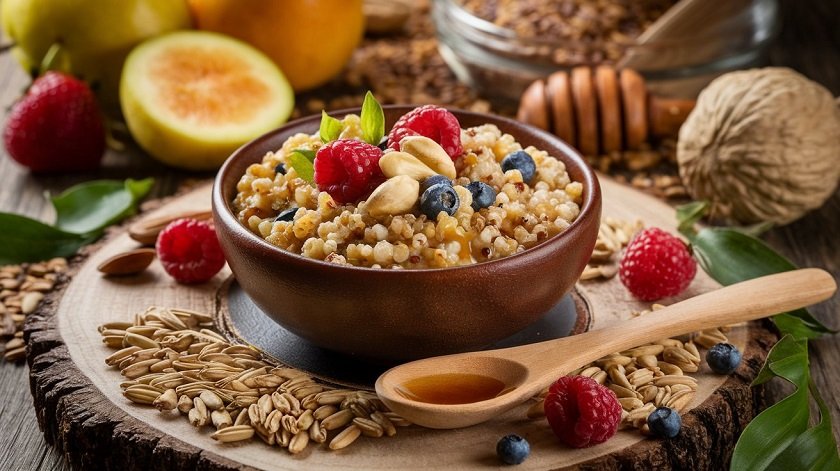In recent years, there has been a growing trend toward healthier, more natural food options. One of the most notable movements in this space is the resurgence of ancient grains—grains that have been cultivated for thousands of years and are now making a strong comeback in modern kitchens. These ancient grains, such as quinoa, farro, spelt, and millet, offer a host of nutritional benefits and are perfect for creating healthy breakfast cereals.
Creating your own healthy cereal at home using ancient grains can be a rewarding and health-boosting endeavor. Not only can you control the ingredients, but you also get to enjoy the full benefits of whole grains, fiber, and essential nutrients. In this ultimate guide, we will walk you through the steps to create your own nutritious and delicious breakfast cereals using ancient grains. We will explore the best grains to use, how to prepare them, and offer tips on flavoring and customizing your cereal.
Why Choose Ancient Grains for Your Cereal?
Before diving into the “how-to” of making cereal with ancient grains, it’s essential to understand why these grains are such a great choice for breakfast.
- Nutrient Density: Ancient grains are packed with vitamins, minerals, and antioxidants. They tend to be higher in fiber and protein than more commonly consumed grains like wheat and corn, making them an excellent option for supporting digestive health and keeping you full throughout the morning.
- Gluten-Free Options: Many ancient grains, such as quinoa, buckwheat, and millet, are naturally gluten-free, making them a perfect choice for those with gluten sensitivities or celiac disease.
- Low Glycemic Index: Ancient grains have a lower glycemic index compared to refined grains. This means they are digested more slowly, helping to stabilize blood sugar levels and prevent spikes and crashes in energy.
- Rich in Flavor: Ancient grains offer diverse, nutty, and hearty flavors that add depth to your homemade cereals, making them more satisfying and delicious compared to typical store-bought options.
With these benefits in mind, it’s clear why incorporating ancient grains into your breakfast routine is a smart choice. But how do you get started with making your own healthy cereal?
Selecting the Right Ancient Grains for Your Cereal
The first step in creating a nutritious cereal is choosing the right ancient grains. Here are some of the best options to consider:
1. Quinoa
Quinoa is one of the most popular ancient grains due to its impressive nutritional profile. It’s rich in protein, containing all nine essential amino acids, making it a complete protein. Quinoa also has a fluffy texture when cooked and a mild, nutty flavor, which makes it a great base for both sweet and savory cereals.
2. Farro
Farro is an ancient type of wheat that has been cultivated for thousands of years. It’s known for its chewy texture and nutty flavor. Farro is high in fiber and protein, and it also contains a variety of important minerals like magnesium and iron. Farro is an excellent choice if you want a cereal that has more substance and a hearty feel.
3. Millet
Millet is a small, round grain that is rich in magnesium, potassium, and antioxidants. It has a slightly sweet flavor, making it an ideal base for breakfast cereals. Millet is naturally gluten-free and easy to digest, making it a great choice for sensitive stomachs.
4. Spelt
Spelt is an ancient relative of wheat, and it has a slightly sweet, nutty flavor with a chewy texture. While it contains gluten, it is often considered easier to digest than modern wheat varieties. Spelt is high in fiber, B vitamins, and several minerals, including manganese and copper.
5. Buckwheat
Despite its name, buckwheat is not related to wheat and is naturally gluten-free. It’s rich in antioxidants, fiber, and essential amino acids. Buckwheat has a distinct earthy flavor, which can complement both sweet and savory cereal recipes.
6. Teff
Teff is a tiny grain that is high in protein, iron, and calcium. It’s often used in Ethiopian cuisine and adds a mildly nutty flavor to cereals. Teff is also naturally gluten-free and offers a rich source of dietary fiber.
How to Prepare Ancient Grains for Cereal
Once you’ve selected the grains you want to use, the next step is to prepare them. Here’s a simple guide for cooking some of the most common ancient grains:
Basic Cooking Method for Ancient Grains
For most ancient grains, you can use the following steps:
- Rinse the grains thoroughly to remove any dirt or impurities.
- Combine 1 cup of grain with 2–2.5 cups of water or plant-based milk (for creamier cereal).
- Bring the mixture to a boil, then reduce the heat to low and cover.
- Simmer for 15–25 minutes (depending on the grain), until the grains are tender and the liquid is absorbed.
- Fluff the grains with a fork and let them cool slightly before serving.
Tips for Customizing Your Cereal
One of the best things about making your own cereal is the ability to customize it to suit your preferences. Here are some tips to make your ancient grain cereal truly your own:
1. Sweeten Naturally
Instead of using refined sugar, try sweetening your cereal with natural options like maple syrup, honey, or coconut sugar. You can also add dried fruits, such as raisins, cranberries, or chopped dates, to boost the sweetness and add a chewy texture.
2. Add Healthy Fats
For extra nutrition, add a handful of nuts or seeds to your cereal. Almonds, walnuts, chia seeds, and flaxseeds are great options that provide heart-healthy fats and a crunchy texture.
3. Boost with Spices
Enhance the flavor of your cereal by adding spices like cinnamon, nutmeg, or cardamom. These spices not only add flavor but also provide anti-inflammatory and antioxidant benefits.
4. Incorporate Fresh Fruits
Fresh fruits like berries, sliced bananas, or diced apples make a perfect topping for your ancient grain cereal. They add natural sweetness and vitamins, making your breakfast even more nourishing.
5. Use Non-Dairy Milks
For a creamier texture, try using plant-based milks like almond milk, oat milk, or coconut milk. These milks pair beautifully with ancient grains and can add subtle flavors to your cereal.
Conclusion
Creating your own healthy cereal with ancient grains is a simple and rewarding way to start your day on a nutritious note. By choosing grains like quinoa, farro, millet, or spelt, you can enjoy the many health benefits these grains provide, from supporting digestion to providing sustained energy throughout the morning. The best part is that you can tailor your cereal to your specific tastes by adding fruits, nuts, spices, and natural sweeteners.
Whether you’re looking for a gluten-free option, a high-protein breakfast, or simply a more flavorful alternative to traditional cereals, ancient grains are a fantastic choice. Experiment with different combinations and find the cereal that works best for you—your body will thank you!
FAQs
- What are ancient grains?
Ancient grains are grains that have been largely unchanged over the centuries and are considered to be more nutritious than modern grains. Some examples include quinoa, farro, spelt, millet, and buckwheat. - Are ancient grains gluten-free?
Some ancient grains, like quinoa, millet, and buckwheat, are naturally gluten-free, making them suitable for people with gluten sensitivities or celiac disease. However, grains like spelt and farro contain gluten. - Can I make a breakfast cereal with ancient grains in advance?
Yes! You can cook ancient grains in bulk and store them in the refrigerator for up to 3–5 days. Simply reheat with a splash of milk and your favorite toppings for a quick and healthy breakfast. - How can I make my homemade cereal more filling?
To make your cereal more filling, add extra protein-rich ingredients such as nuts, seeds, or yogurt. You can also mix in chia seeds or flaxseeds, which are high in healthy fats and fiber. -
Are there any specific benefits to eating ancient grains?
Yes, ancient grains are typically higher in fiber, protein, and important vitamins and minerals compared to refined grains. They support digestive health, stabilize blood sugar levels, and provide sustained energy throughout the day.

